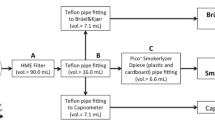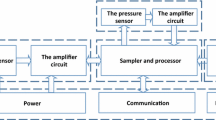Abstract
Objective.The aim of this study was to improve the accuracy of the chemiluminescent analyser in the measurement of nitric oxide (NO) and nitrogen dioxide (NO2) in both dry and humidified gas mixtures containing oxygen (O2) in varying concentrations. This work was performed because initial attempts to determine rate constants for the decay of NO and rates of formation of NO2 were unsuccessful. Methods.Equations were developed by which the raw output signal of the analyser could be corrected for errors arising from variations in sensitivity of the analysis cell, degree of conversion of NO2 to NO and degradation of NO to nitrogen (N2) in the converter prior to analysis. Once correction factors were derived from calibration, the analyser was used to measure rate of decay of 40 ppm nitric oxide in both dry and humidified gases containing either 21%, 60% or 100% O2 in N2. Results.Correction factors obtained from calibration corrected falls in sensitivity to a maximum of 28%, variations in degree of conversion of NO2 to NO from 62–96% and degradation of NO from 2–8% in the converter before analysis depending on O2 concentration and humidification. When the calibrated machine was used to measure decay of NO, an excellent fit (r 2 > 0.95) with a hyperbolic function was obtained confirming that rate of decay is proportional to oxygen O2 concentration and square of NO concentration. A rate constant per unit O2 concentration of 9.40E-10 ppm−2 min−1 for humidified gas was significantly higher than 8.27E-10 ppm−2 min−1 for “dry” gas (P= 0.008) at 22 °C. Rise in NO2 predicted from the “wet” rate constant achieved 3ppm in 65 seconds with 40 ppm NO in 100% oxygen and 107 sec. in 60% oxygen. ConclusionThis study indicates that for accurate analysis of NO and NO2 concentrations in airway gases a rigorous calibration of the instrument for the conditions applying in the experiment is mandatory. Once this is achieved the instrument is capable of precise analysis of both gases.
Similar content being viewed by others
REFERENCES
Foubert L, Fleming B, Latimer R, Jonas M, Oduro A, Borland C, Higenbottom T. Safety guidelines for use of nitric oxide. Lancet 1992; 339: 1615–1616
Bouchet M, Renaudin MH, Raveau C, Mercier JC, Dehan M, Zupan V. Safety requirement for use of inhaled nitric oxide in neonates. Lancet 1993; 341: 968–969
Miyamoto K, Aida A, Nishimura M, Nakano T, Tawakami Y, Ohmori Y, Ando S, IchidaT. Effects of humidity and temperature on nitrogen dioxide formation from nitric oxide. Lancet 1994; 343: 1099–1100
Sievers NO2 Converter, Operation and Service Manual Revision A, March 1996, Sievers Instruments Inc. 6185 Arapahoe Ave, Boulder, CO 80303, U.S.A.
Van der Mark TW, Kort E, Maizer RJ, Postma DS, Koeter GH. Water vapour and carbon dioxide decrease nitric oxide readings. Eur Respir J 1997; 10: 2120–2123
Baulch DL, Drysdale DD, Horne DG. Evaluated kinetic data for high temperature reactions, Volume 2, Homogeneous gas phase reactions of the H2-N2-O2 system. London: Butterworths, 1973
Miller CC. Chemiluminescence analysis and nitrogen dioxide measurement Lancet. 1994; 343: 300–301
Etches PC, Harris ML, McKinley R, Finer NN. Clinical monitoring of inhaled nitric oxide: Comparison of chemiluminescent and electrochemical sensors. Biomed Instrum Technol 1995; 29: 134–140
Goldman AP, and Macrae DJ. Nitrogen dioxide measurement in breathing systems. Lancet 1994; 343: 850
Waldorf DM, Babb AL. Vapor-phase equilibrium of NO, NO2, H2O and HNO2 J Chemical Physics 1963; 39 (2): 432–435
McCleverty JA. Reactions of nitric oxide coordinated to transition metals. Chemical Review 1979 (1): 53–76
Gerrard W. Gas solubilities, widespread applications. Oxford Pergamon Press, 347–356
Author information
Authors and Affiliations
Rights and permissions
About this article
Cite this article
Salamonsen, R.F. Improving Accuracy of the Chemiluminescent Analyser for Measurement of Nitric Oxide and Nitrogen Dioxide in Respired Gas. J Clin Monit Comput 17, 173–179 (2002). https://doi.org/10.1023/A:1020788417368
Issue Date:
DOI: https://doi.org/10.1023/A:1020788417368




